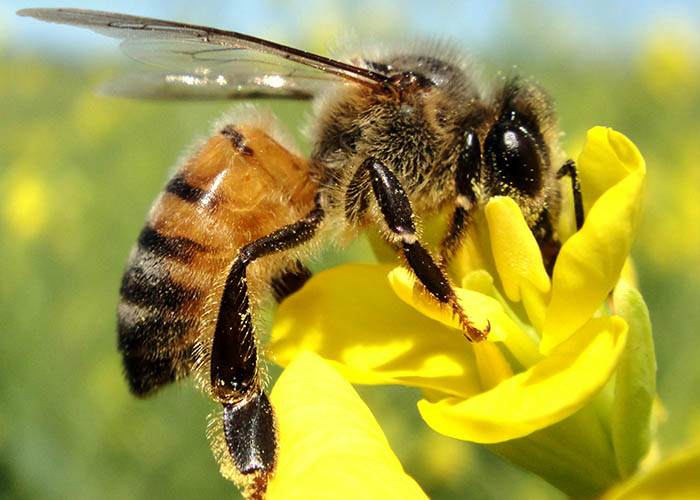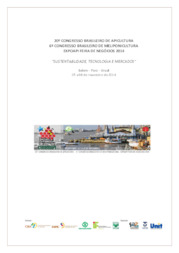European bee glue inhibits fungus that attacks maize, citrus and tomatoes
European bee glue inhibits fungus that attacks maize, citrus and tomatoes
The propolis or bee glue produced by European bees (Apis mellifera) works against the fungus P. aphanidermatum, a microorganism that causes stem rot and felling in seedlings of different crops such as maize, citrus, tomatoes, beets and bell peppers. The scientific discovery was part Wallance Pazin's PhD work for the University of São Paulo (USP), carried out with the participation of Embrapa Environment. He assessed the action of four types of bee glue collected in different regions of Brazil.
The insect's product is called green bee propolis and its preventive and therapeutical traits are known by science, which has already proven some of its antimicrobial, antitumor and antioxidant properties. This finding, aimed at agricultural applications, paves the way for the development of natural defensives at affordable prices, which makes it especially valuable for smallholders.
During the work at Embrapa, supervised by the researcher Sonia Queiroz, previously selected bioactive substances were isolated from green propolis. “Green propolis, which is known as 'nature's green gold', is a true gift for our health. It is produced when Africanized bees extract the resin of a plant locally known as "alecrim do campo" (Baccharis dracunculifolia), which is abundant in Brazil”, the scientist elucidates.
Pazin explains how the research isolated and identified the active substance Artepillin C. Found among other green propolis compounds, the molecule was the main one responsible for several action mechanisms against different pathogen species. The research proved the pharmacological importance of the molecule, especially due its antioxidant, anti-inflammatory and anticancer potential.
PropolisFrom all the existing types of propolis (or bee glue), the one collected by the Apis mellifera bee species, which is called green propolis, is the one that enjoys greatest prestige worldwide and that has been traded and exported the most to pharmaceutical industries, especially in Japan. That is due to its wide range of disease-prevention and treatment actions, as well as its anti-inflammatory, antimicrobial, anticancer and antioxidant properties. The bioactive agents found in this product depend on the type of vegetation to which the bee has access in the region and the specific selectivity of each species in the collection, possibly due to the need for antimicrobial activity within the beehive. |
After isolating the bioactive substance and assessing its antifungal activity, Pazin continued his research at USP - Ribeirão Preto, the University of Southern Denmark (SDU), and the Eindhoven University of Technology (TUE), in the Netherlands. He also observed that the compounds with higher bioactivity present in the bee glue are capable of interacting with the cell membrane, the film that involves the cell. Artepillin C has proved to be capable of changing the membrane's properties, which allows the molecule to be more efficient in disease control. This part of the work was published in the scientific journal European Biophysics Journal.
A sustainable and affordable future product
The application of a propolis-based product to inhibit the growth of this microorganism species is at development stage. With an affordable antifungal agent, smallholders could benefit from the technology to control the diseases caused by the P. aphanidermatum fungus, with the advantage that it will be a natural, non-toxic and safe product for human consumption and for the environment", Pazin anticipates.
“Three hundred stingless indigenous bee species have been identified in Brazil. Such species' population growth leads to a potential source of natural pharmacological products, such as those found in the bee glue and honey”, assesses the biological physicist, clarifying that bee glue is completely different from honey.
Each bee species is capable of collecting plant substances and forming different types of bee glue, which depend on the environment where they live and on the plant sources they have. Bee glue has antimicrobial action within the colonies and thus protects them from harmful microorganisms.
The study also showed that the Cerrado region is a rich source of biodiversity and has a large concentration of the plant species Baccharis dracunculifolia, which has a similar chemical constitution to such propolis. The discovery also awakened the interest in the plant species as a natural source of new bioactive compounds.
“Since the compounds found in any given type of bee glue differ, it suggests that there are compounds that have not been identified yet in indigenous bee propolis that could have antioxidant action and that require further study", Pazin asserts. In his research, he discovered that the propolis collected by the native bee Melipona quadrifasciata anthidiodes, locally known as "mandaçaia", presented an antioxidant action as significant as the one produced by European bees.
Participants in the research include the professor of USP - Ribeirão Preto's College of Philosophy, Sciences and Letters Amando Ito, PhD advisor; the professor of USP - Ribeirão Preto's College of Medicine Ademilson Espencer Soares; and the researcher Andresa Berreta, from the company Apis Flora.
Translation: Mariana Medeiros
Cristina Tordin (MTb 28.499/SP)
Embrapa Environment
Press inquiries
meio-ambiente.imprensa@embrapa.br
Phone number: +55 19 3311-2608
Further information on the topic
Citizen Attention Service (SAC)
www.embrapa.br/contact-us/sac/



